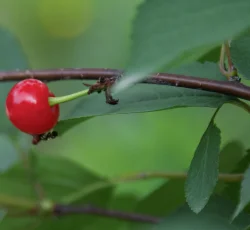
Pawpaw
Asimina triloba
This small, colonizing tree produces the largest edible fruit indigenous to the United States. It has dark maroon flowers in the early spring which are pollinated by flies.
EXPLORE THIS PLANT
This small, colonizing tree produces the largest edible fruit indigenous to the United States. It has dark maroon flowers in the early spring which are pollinated by flies.
EXPLORE THIS PLANT
Peaches are wide fast growing trees that require careful pruning and maintenance in order to produce good quality fruit. Their vibrant pink flowers in spring are charming and attractive to pollinators.
EXPLORE THIS PLANT
Like other fruit trees, pears require a good deal of maintenance in order to perform well. Many require a chilling period to fully ripen and are good for use in baking and cidermaking.
EXPLORE THIS PLANT
Persimmons are an unusual American fruit that can colonize in abandoned fields and open woods. Female trees bear astringent orange fruits that become fully ripe after a frost.
EXPLORE THIS PLANT
Plums have a sprawling, suckering growth habit and therefore require judicious pruning.
EXPLORE THIS PLANT
This native plant is a medium deciduous tree with large white flowers in the spring and striking cigar-like seedpods in the fall. It features large heart-shaped leaves.
EXPLORE THIS PLANT
An iconic tree of the south, magnolias are beautiful in both form, leaf, and flower. Widely for their fragrant blooms, they also provide winter interest with both their seedpods and shiny evergreen leaves which are often used in wreaths.
EXPLORE THIS PLANT
This stately tree is well-known for its fall color and production of maple syrup. It is a tree of northern forests and does not tolerate the heat or humidity of the south.
EXPLORE THIS PLANT
On a winter's day, the sight of the sycamore's bright white trunk against a blue sky is breathtaking. This tree can grow to massive proportions when well-sited and should be given plenty of space, especially since they can be messy.
EXPLORE THIS PLANT
Cherry tree species grown primarily for fruit production bloom later than the ornamental varieties. Tart cherries perform best in the humid climate of Virginia's coastal region.
EXPLORE THIS PLANT